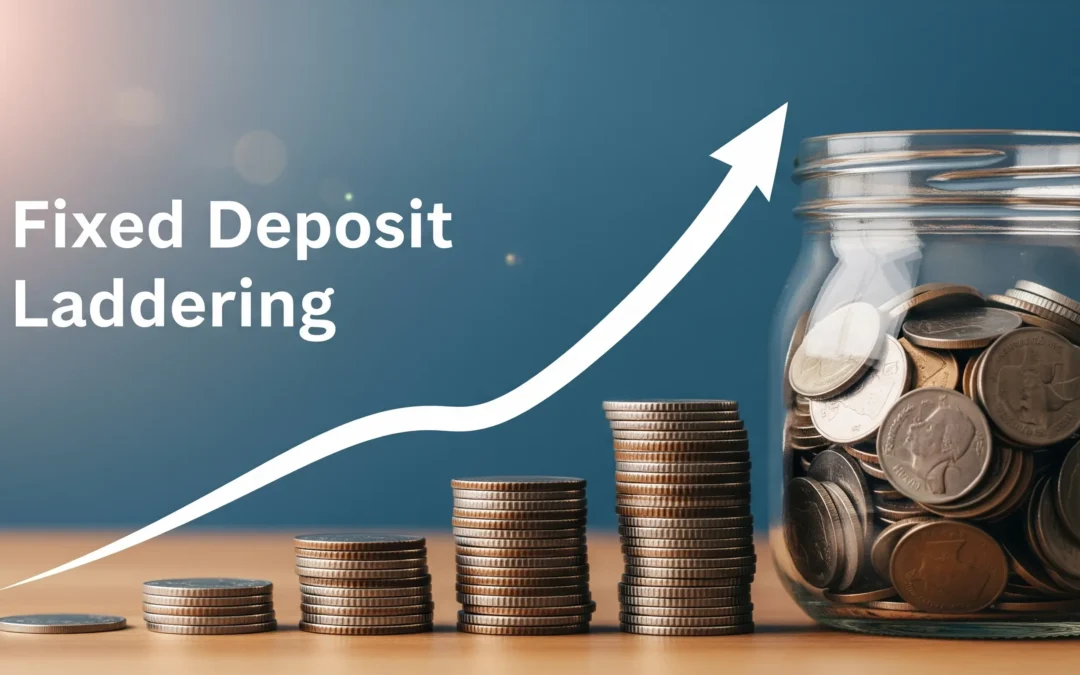In a world of uncertain markets and volatile returns, most investors turn to the certainty of fixed-income products such as Bank Fixed Deposits (FDs). While they guarantee returns and capital protection, investing a sum in a single deposit usually costs you in terms of flexibility and exhausts your earning capacity. That’s where the FD Laddering Strategy enters the picture, a systematic way of handling your savings.
It splits your investment across different tenures and increases your earning potential. Curious how? Let us get into the details of the Bank FD laddering strategy.
What is Bank FD Laddering?
Bank FD laddering is splitting up the entire amount that you were planning to put in one FD into smaller sums and using them to invest in different fixed deposits with various maturities. The FDs mature one after the other, creating a ladder that gives a return at regular intervals from different FDs.
It is suitable for individuals who opt for FD, considering it a low-risk investing option, but expect a slightly higher return than it originally offers. Laddering provides a mix of stability and efficiency, making risks minimal and returns guaranteed.
Key Features:
- Gives an option of reinvestment at the current rate
- Generates a consistent annual or periodic cash inflow
- Permits higher rates of reinvestment when market rates increase.
- Reduces the penalties for early withdrawal.
- Provides flexibility in tax planning by allocating interest income.
Example:
Suppose Mr. A wants to invest Rs. 3,50,000. The following table represents how he can ladder it across 5 years. To calculate the maturity value of each FD in the laddering strategy, the following formula is used:
Maturity Value = Principal × (1 + Annual Interest Rate)^(Tenure in Years)
This formula is suitable when interest is compounded annually.
| Year | FD Amount | Tenure | Interest Rate (Assumed) | Maturity Value (₹) Calculation | Maturity Value (₹) |
| 1 | ₹70,000 | 1 year | 6.5% | (70,000 × (1+ 0.065)) | ₹74,550 |
| 2 | ₹70,000 | 2 years | 7.0% | (70,000 × (1+ 0.07)2) | ₹80,143 |
| 3 | ₹70,000 | 3 years | 7.2% | (70,000 × (1+ 0.072)3) | ₹86,234 |
| 4 | ₹70,000 | 4 years | 7.3% | (70,000 × (1+ 0.073)4) | ₹92,789 |
| 5 | ₹70,000 | 5 years | 7.5% | (70,000 × (1+ 0.075)5) | ₹1,00,494 |
Bank FD Laddering: Pros and Cons
After understanding the meaning of bank FD, laddering, you might be wondering if it is actually worth it or not. Let us look into the pros and cons to find the answer to the same.
Pros
- Better liquidity: It allows you to access a portion of your money each year without bearing the penalty of early withdrawal.
- Interest Rate Advantage: Take advantage of higher rates as you can reinvest the amount at the current market rate.
- No long duration lock-in: Laddering allows periodic cash flow as the maturity rates are different, preventing lock-in stress.
- Flexibility and discipline: Promote consistent reinvestment while permitting adjustments in accordance with objectives.
Cons:
- Needs multiple FDs to be planned and tracked, making it a time-consuming and difficult approach.
- All FD interest is subject to taxes, which could lower net returns.
How Bank FD Laddering Helps in Maximizing Returns
Bank FD laddering is more than just splitting deposits into smaller amounts; it’s a strategic approach to boost productivity, profits, and financial control. Although FDs are fixed-income instruments, how you structure them has a significant impact on the net benefit you receive. The following are some ways that laddering can help you prudently maximise your returns:
- Advantages of Rising Interest Rates
- One of the most admirable aspects of laddering is its ability to capture future rate increases.
- Interest rates are influenced by market demand, inflation, and the RBI policy.
- Gets Better Rates and Lowers Opportunity Cost
- If you are uncertain whether the current rates are at their peak or are expected to rise, laddering spreads your risk.
- Rather than locking in the full amount at the current rate, you have the choice to transfer some of your investment to better options as they mature.
- Eliminate the Need for Prompt Withdrawals
- There may be interest penalties or even a loss of interest income if an FD is broken early.
- Several maturity dates increase liquidity by providing periodic cash flows, which lowers the likelihood of an early withdrawal.
- Efficient Cash Flow Management
- Because the cash flows can be reinvested at a higher rate or used for emergency funds, EMI payments, or other purposes, they can lead to better management.
- By ensuring that money is available exactly when needed, it reduces reliance on credit or loans.
Let us compare Laddering vs Single FD:
| Investment Strategy | Average Rate Over 5 Years | Liquidity | Reinvestment Opportunity | Risk of Premature Break |
| Single FD (5 yrs @6.5%) | 6.5% | No | No | High |
| Laddering (1 – 5 yrs) | 6.5% to 7.5 %+ (dynamic) | Yes | Yes (at higher rates) | Low |
Bottomline
The conclusion can be drawn that Bank FD laddering is an investment option that provides the safety of an FD along with much better liquidity. It enables the investor to access a portion of their fund as they mature across the ladder. The investor can either use it according to the situation or reinvest it at a higher interest rate for better profits.
FD laddering ensures better financial planning along with good liquidity. No more blocking of funds for a decade to earn an average interest rate just for safety. It provides an option to earn more while being risk-averse.
Written by: Tanya Kumari


